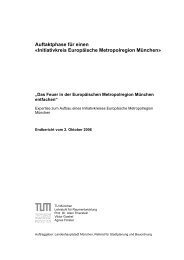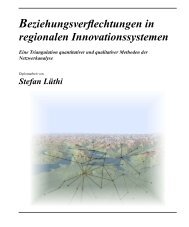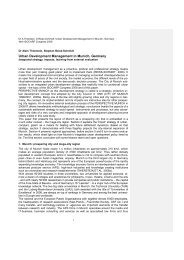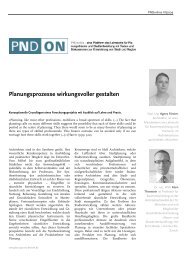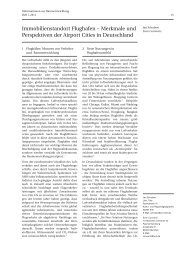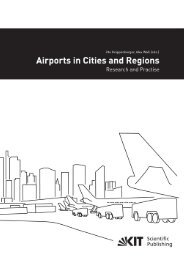0.6-1-Cover and Table of Contents-pp 0-05.indd - Raumentwicklung ...
0.6-1-Cover and Table of Contents-pp 0-05.indd - Raumentwicklung ...
0.6-1-Cover and Table of Contents-pp 0-05.indd - Raumentwicklung ...
Create successful ePaper yourself
Turn your PDF publications into a flip-book with our unique Google optimized e-Paper software.
SMALL URBAN GREENERY: MAPPING AND VISUAL ANALYSIS IN<br />
KYŌJIMA-SANCHŌME<br />
Jorge Almazán, Darko Radovic, <strong>and</strong> Tomohiro Suzuki<br />
Abstract<br />
This paper illustrates the practice <strong>of</strong> maintaining<br />
small greenery in a typical high-density, low-rise<br />
district in Tokyo through extensive ma<strong>pp</strong>ing <strong>and</strong><br />
systematic photographic analysis <strong>of</strong> vertical green<br />
coverage. Overlooked by statistics based on aerial<br />
photography, this paper describes small greenery<br />
<strong>and</strong> the way in which it improves urban scenery.<br />
As more cities are planning to increase their<br />
green surface, this paper aims to bring attention<br />
to the potential role <strong>of</strong> environmental <strong>and</strong> social<br />
sustainability played by small-scale vegetation. Such<br />
greenery, spontaneously cultivated by residents, not<br />
only contributes to embellishing the streets, but also<br />
serves as a social device to personalize <strong>and</strong> subtly<br />
characterize territories, while expressing the creativity<br />
<strong>and</strong> cohesion <strong>of</strong> the community.<br />
Keywords<br />
Greenery; Ma<strong>pp</strong>ing; Vertical green coverage;<br />
High-density; low-rise<br />
Introduction<br />
Background <strong>and</strong> purpose<br />
Throughout history, greenery has been considered<br />
an indispensable element in architecture <strong>and</strong><br />
urban design because <strong>of</strong> its environmental,<br />
aesthetic, <strong>and</strong> recreational benefits. Even in<br />
the revolutionary avant-garde developments<br />
<strong>of</strong> the early 20th century, which aimed to make<br />
a radical departure from previous ideas on<br />
architecture <strong>and</strong> urbanism, vegetation was a<br />
dominant feature, such as in Ebenezer Howard’s<br />
Garden City <strong>and</strong> Le Corbusier’s Radiant City.<br />
Today, studies on sustainability emphasize the<br />
multiple environmental benefits <strong>of</strong> greenery<br />
in urban environments: climate modification,<br />
carbon sequestration, ozone reduction (<strong>and</strong><br />
consequently smog reduction), dry deposition<br />
<strong>of</strong> NOx, O3, <strong>and</strong> PM10 particulates, decreased<br />
rainwater run<strong>of</strong>f, <strong>and</strong> protection against flooding<br />
(Ong, 2003: 198). This thesis aims to inspire<br />
practitioners <strong>and</strong> contribute to the underst<strong>and</strong>ing<br />
<strong>of</strong> the relationship between greenery <strong>and</strong> the<br />
everyday practice <strong>of</strong> space through a case study<br />
in Tokyo.<br />
Copyright © 2012 Archnet-IJAR, Volume 6 - Issue 1 - March 2012 - (57-76)<br />
Archnet-IJAR, International Journal <strong>of</strong> Architectural Research<br />
57




